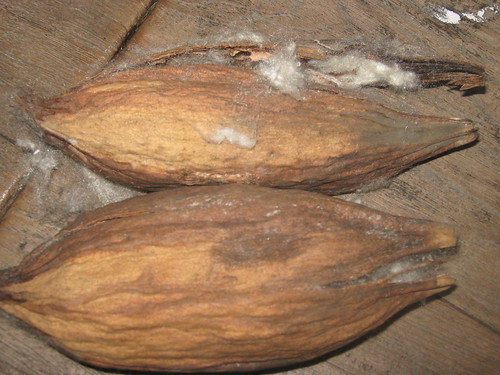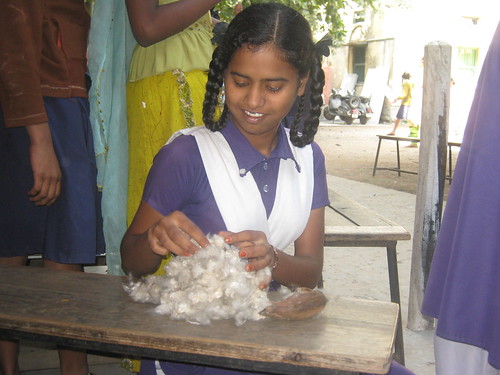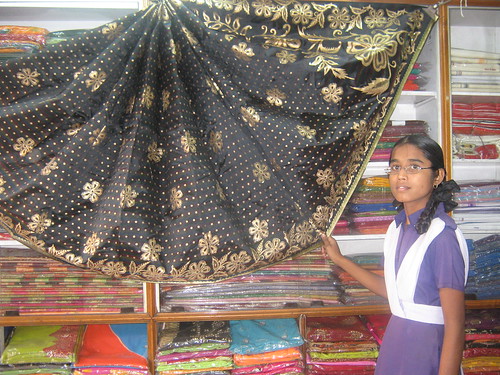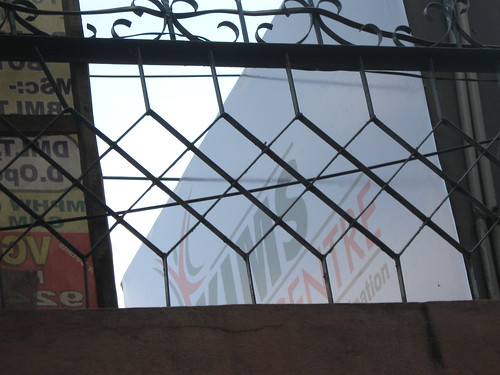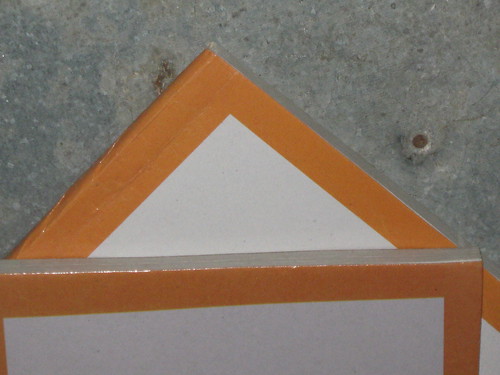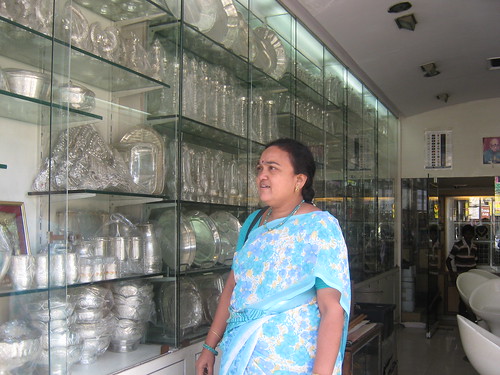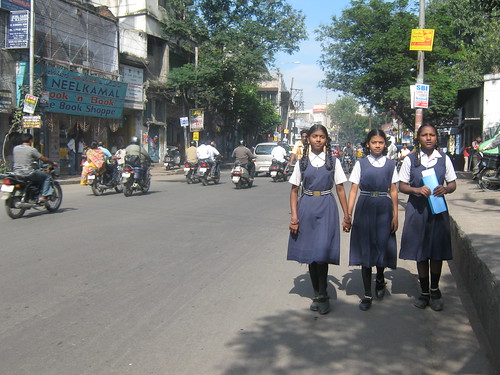Railway Girls School: 79th Annual Day Celebrations
If you had stopped by to visit us in our apartment this past Thursday afternoon, around 2pm, you would have found Kara and I desperately trying to wrap our own saris – tangled up like bugs in a web of cloth. We were due to hop an auto in just twenty minutes to head to Railway for the school’s 79th Annual Day Celebrations. Luckily, we have very kind neighbors, and after two knocks on the nearest doors, Smt. Pandya rushed over to save us from a sea of sari fabric. Demanding some safety pins, she happily set to work wrapping us up like presents, enlisting the help of Srilatha, one of the hospital’s young housekeeping staff members. Vandana and Srilataha pleated and turned and tucked and pinned, until Kara and I both looked remarkably clean cut and formal – it was an incredible transformation that I certainly couldn’t have accomplished with my own two hands.
Dressed (and assured that the safety pins would keep us from unraveling half way to Lallaguda,) we said goodbye to our surrogate big sisters/mothers/wise women and headed to the Railway Girls School. When we arrived, the late afternoon sun was sinking quickly into the earth and the school was glowing with the excitement of the teachers and students inside. A big colorful tent had been erected for parents and aunties and uncles and cousins to sit under, and the stage at Railway was set up as on Teacher’s Day – a colorful spread of paper flowers on a table in front of chairs for the guests of honor, a podium, microphones, and a sound table to the side. Mr. Prabhaker greeted us with a huge smile – he beamed like a proud father – and told us that we were free to photograph and do as we like “you are one of us now! You shall be back here [backstage] with us if you like!” I couldn’t have asked for a more heartwarming declaration of acceptance and belonging from the school community.
Kara and I were quickly ushered inside and to the classrooms-turned-dressing rooms (one for the girls playing girls, and one for the girls playing boys!) and swarmed by students who wanted us to take pictures of them in their finery. The costumes were stunning – so colorful and extravagant – and the stage makeup the girls had applied with such expertise (and some help from Shailaja) made them look like little dolls.
Some of the girls had their hair down – a striking contrast to the crisp, neatly tied plaits and bows of the school day – and they all seemed freed and enthused by the change in costume. Some of them looked so stunningly mature and composed in their traditional dance attire – I had a hard time remembering that the little women in front of me, who looked so sure of themselves and their talent, were the same girls who’d been afraid to ask me “why?” four months ago. I am proud to report that every girl in our 8th class seems to have a bit of a performer inside of her, and it is brilliant to watch this small bit of extraordinary confidence assert itself in such a bold way on stage.
After a few hundred pictures in the dressing rooms (really, I’m not exaggerating,) Kara and I stepped into the teacher’s room to sip some tea and have samosas. Almost before we could finish our chai, we were once again set upon by a few teachers and students who kindly helped us adjust whatever odds and ends of our saris had become slightly loose.
Finally, it was time for the program to begin. Kara and I gathered in the computer lab with Preethi (one of our 8th class students,) and Navya, a 10th class former TMS student, to give a small presentation to the official guests of the evening: Sri T.P.V.S.Sekhara Rao (CPO/IR/SCR/SC), Smt. Sujatha J. Prasad (Vice President/SCRWWO/HYB), Sri. P. Srinivasulu (President/Sr.DPO/HYB). At Mr. Prabhaker’s request, I had edited a small video compilation of the work we’ve been doing this year, as well as some of the work done by students last year. We screened the short film for our guests, and Preethi and Navya gave small, eloquent speeches about how much they love the digital storytelling classes, and the confidence and happiness they fill them with. Hopefully we will be able to post audio from Navya’s speech soon – she agreed to record it for us when classes resume in January.
[vimeo 17721297]
After TMS’ presentation, and a peek at the girls’ “handicrafts” display, the official guests took their seats on the stage, and Mme. Janaki proceeded with introductions, followed by speeches from the official guests, the distribution of awards for students who excelled in athletics and who scored high marks on their exams.
Then, at last, we arrived at the part of the evening that all in attendance had been waiting for (the lower standard students sat remarkably patiently in the fading light) – the cultural performances.
Telugu dances, comedy sketches, upbeat performances by the very youngest students with the most frilly costumes, and oddly enough, a little Christmas pageant – everything was absolutely wonderful. The poise, grace, skill, and professional attitude that some of the girls brought to the stage were really remarkable – whatever shyness or hesitancy they felt or exhibited in the classroom simply vanished when they were on stage. They worked the crowd, knew how to make them laugh, threw their entire bodies into every small step and spin, and I have never seen them look so happy.
Mr. Prabhaker, looking on proudly.
The crowd was enthralled and entirely supportive – cheering loudly when the smallest dancers shook their hips and pompoms, and chuckling at the jokes peppering the skits. Watching the faces of those in the audience was almost as fun as watching the performers on stage.
When the last note had left the speakers, and the curtain closed for good, the girls rushed back stage to change into their comfortable kurtas and leggings, transforming back into the thirteen year old girls we’ve come to know so well. It was an honor to meet some of the girls’ elder sisters (former Railway students themselves,) and wonderful to see so many former students greet their old teachers with affection. Railway is an incredible community – doing so much for their girls with whatever little they have – and it shows in the joy that everyone takes in being together to celebrate with dance and song. I feel incredibly lucky to be accepted as real part of this community, and grateful to have such wonderful students and teachers in my life.
For now, I give you a few of the many photos that I took Thursday evening. Soon, we shall have the video of the performances uploaded and edited to so that you too may enjoy them as well. Stay tuned!


































